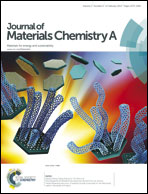A wavy graphene/platinum hybrid with increased electroactivity for the methanol oxidation reaction†
Abstract
Two distinct graphene sheets, highly flat graphene and wavy graphene, were used as support materials for in situ nucleation and growth of platinum nanoparticles (Pt NPs) to synthesize graphene/Pt catalysts. The average size of Pt NPs on the wavy graphene sheets is around 2 nm and is smaller than those on the flat graphene sheets. The electrochemical activity of the two as-prepared catalysts towards methanol oxidation was investigated and compared with that of a commercial Pt/carbon black (Pt/C) catalyst, and electrochemical results showed that the wavy graphene/Pt catalyst possessed the best poison tolerance and comparable electrochemical surface area to the commercial Pt/C catalyst. The wavy microstructure is believed to be responsible for the stable dispensability of the as-prepared wavy graphene and the acquisition of small size Pt NPs, since the abundant ripples coming from the wavy microstructure effectively prevent the aggregation of the graphene sheets, and also act as barriers to prevent agglomeration of Pt NPs during their in situ nucleation and growth process. This work indicates that the microstructure of the supporting material plays a crucial role in the electrochemical performance of platinum-based catalysts.


 Please wait while we load your content...
Please wait while we load your content...